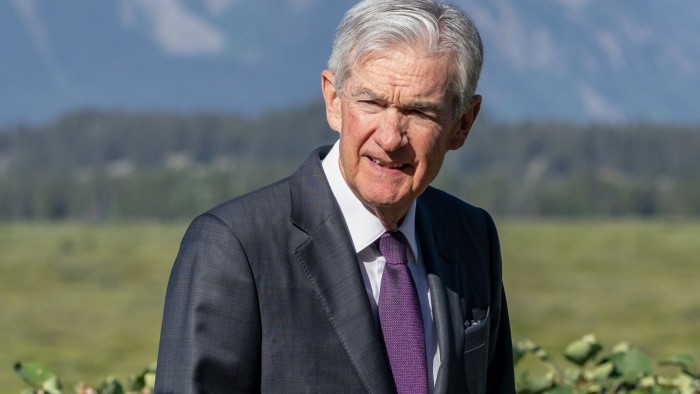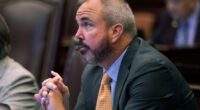Share this @internewscast.com
Unlock the Editor’s Digest for free
Jay Powell has signaled a potential Federal Reserve rate cut in September, stating that a weakening US labor market could counteract the inflation risks posed by Donald Trump’s tariffs.
“With policy in restrictive territory, the baseline outlook and the shifting balance of risks may warrant adjusting our policy stance,” Powell said during the Kansas City Federal Reserve’s economic summit in Jackson Hole, Wyoming, on Friday morning.
Powell’s statements align him with the more dovish members of the Federal Open Market Committee, indicating he might support a quarter-point rate reduction at the central bank’s upcoming meeting in September.
After his speech, US government debt saw significant gains. The yield on the two-year Treasury note, which responds to monetary policy expectations, fell by 0.1 percentage points to 3.69 percent. The blue-chip S&P 500 index on Wall Street rose by 1.6 percent, and the dollar depreciated roughly 0.9 percent against a basket of six currencies.
This discussion takes place during a critical period for the Fed. The US president and his supporters have mounted an aggressive campaign against Powell and other senior Fed officials, demanding substantial rate cuts from the central bank.
Rather than complying, the Fed has maintained its main rate in the 4.25-4.5 percent range this year, after implementing a 1 percentage point reduction in 2024, as some officials are concerned Trump’s tariffs on US trading partners could lead to another wave of inflation.
Though Powell acknowledged the effects of the administration’s trade war on consumer prices were now “clearly visible”, he signalled it was unlikely their impact would endure and would instead prove a one-off shock that the central bank could look through.
“Given that the labour market is not particularly tight and faces increasing downside risks, that outcome does not seem likely,” the Fed chair said.
He added that “risks to inflation are tilted to the upside, and risks to employment to the downside — a challenging situation”.
A gloomy July jobs report, which showed a sharp slowdown in hiring growth this summer, has prompted many Wall Street banks and investors to forecast a rate cut as soon as September.
Trading in fed funds futures pointed to a 90 per cent chance of a quarter-point rate cut in September, up from 75 per cent on Thursday, according to CME Group data.
“Powell opened the door to a September rate cut with his remarks, emphasising downside risks to employment and relatively contained risks to inflation,” said Gennadiy Goldberg, head of US rates strategy at TD Securities.
Kay Herr, US chief investment officer for global fixed income at JPMorgan Asset Management, echoed that sentiment, saying: “It did sound like [Powell] is more concerned about the labour market side of the dual mandate than he is about inflation.”
Cyclical and industrial stocks, which tend to climb alongside hopes for a stronger economy, led the equity market gains on Friday, underscoring the upbeat reaction to the rising expectations for rate cuts.
A basket of consumer discretionary stocks rose 2.7 per cent, with industrials up 2.6 per cent. Shares in small-cap companies, which are similarly viewed as a proxy for the economy, soared, with the Russell 2000 index up more than 3 per cent.

Still, some top Fed officials have remained concerned that while consumer prices have yet to show much impact from the duties, they could still rise in coming months.
Walmart, the world’s biggest retailer, warned this week the levies were beginning to push up its costs as it cycles through inventory that was purchased before they were put into place. An elevated reading on producer prices has also pointed to a potential future rise in inflation.
Wall Street economists said upcoming monthly jobs and consumer price index reports, due ahead of the Fed’s September 16-17 meeting, would also be crucial in informing the central bank’s next policy steps.
Fed governors Michelle Bowman and Christopher Waller dissented with the central bank’s decision to hold rates steady in July, arguing it should begin to reduce borrowing costs from restrictive levels.
Adriana Kugler’s decision to resign as a Fed governor earlier this month paved the way for Trump to nominate Stephen Miran, a White House economic adviser who shares the president’s views on interest rates, to the central bank’s board. If confirmed by the Senate, Miran could take part in the September Federal Open Market Committee meeting.
The Trump administration has also this week escalated its attack on the Fed, with the president threatening on Friday to fire governor Lisa Cook if she does not resign after a US housing regulator accused her of mortgage irregularities. The justice department on Thursday called on Powell to sack Cook, a step the Fed chair does not have the authority to make.
Cook has said she would not be “bullied” into resigning, and will review the accusations made against her by Bill Pulte, the head of the Federal Housing Finance Agency.





